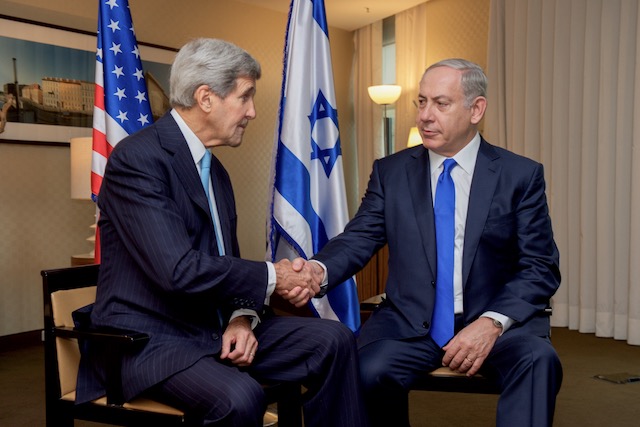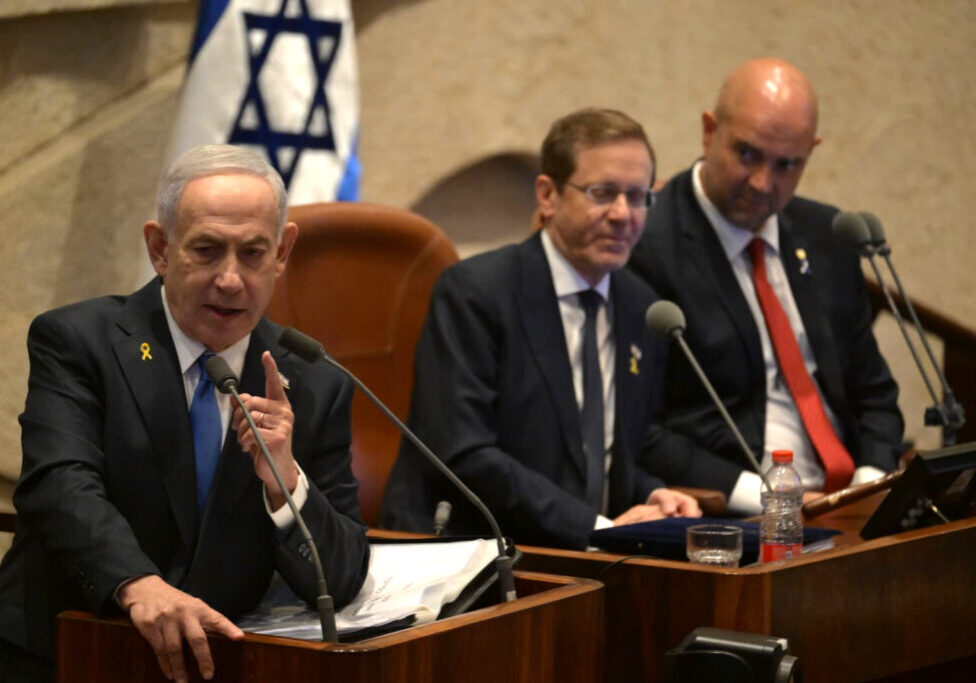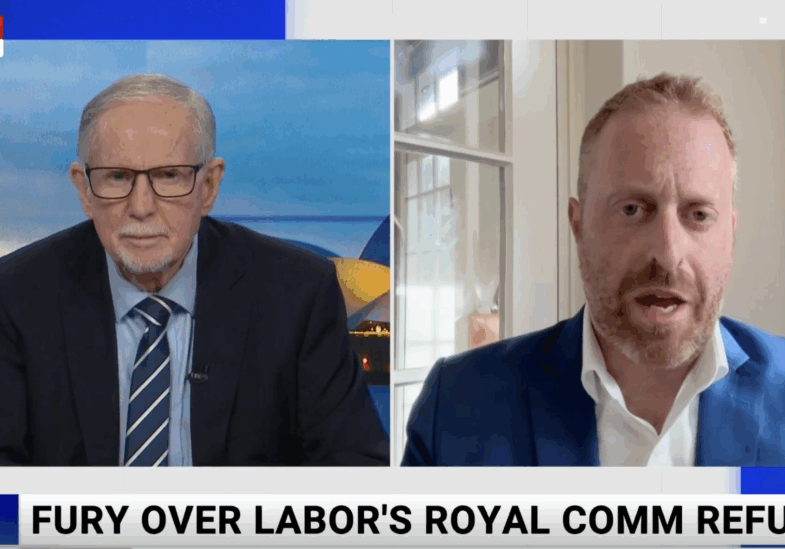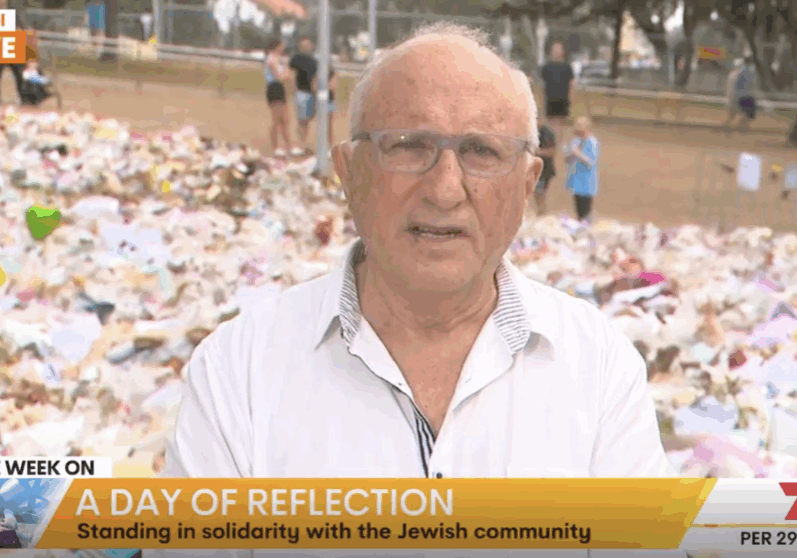FRESH AIR
UPDATES
Reports: Netanyahu has secretly been advancing regional peace plan
March 9, 2017 | Ahron Shapiro

Since taking office in 2009, Israeli Prime Minister Binyamin Netanyahu has often been criticised in the media for supposedly not doing enough to promote peace with the Palestinians and ultimately being responsible for the lack of progress in the peace process.
However, in recent days, new reports in the US foreign policy magazine, The American Interest, and Israel’s left-leaning Ha’aretz daily have emerged detailing backchannel negotiations and discreet peace initiatives that Netanyahu and his emissaries have been making with – not only the Palestinians – but Egypt and a number of Arab states.
Israeli peace negotiator Brigadier General (Ret.) Michael Herzog’s landmark feature-length article in The American Interest is written as an insider’s memoir of participation in former US Secretary of State John Kerry’s nine-month peace initiative of 2013-2014.
Herzog – no supporter of Netanyahu’s side of politics (he is the brother of Labor party leader Isaac Herzog) – nevertheless depicts Netanyahu as “serious” about peace discussions.
According to Herzog’s account, Netanyahu was immersed intimately, in detail, and on a daily basis with backchannel peace negotiations, both before and during Kerry’s initiative.
Herzog also takes issue with Kerry’s claim that Israel, and Netanyahu by default, was responsible for the failure of the initiative.
Herzog reveals that under Netanyahu, Israel had been conducting backchannel negotiations with the Palestinians. “These were what might be characterized as ‘Track 1.5′ – carried out by non-governmental people but with the knowledge of their leaders, who blessed them and awaited their outcome.”
According to Herzog, the very public Kerry Initiative – which imposed a nine-month deadline for Palestinian and Israeli negotiators to resolve the conflict – didn’t replace the backchannel track, but ran concurrently with it, complicating the negotiations. Furthermore, during one phase of the talks, US mediators shuttled messages between the Palestinian and Israeli sides, breeding distrust and suspicion – later proven correct – that the US was often promising things to one side that hadn’t been agreed upon by the other.
Contrary to Kerry’s claims later, Israel had informed the US and the Palestinian side that Palestinian prisoner releases used to bring the Palestinian side to the table would be accompanied by settlement or Jerusalem housing announcements in order to mollify Israeli public criticism over the prisoner releases. These announcements were not surprises.
Herzog wrote about Netanyahu’s personal involvement in the talks:
“…we were astonished to learn that the US side had not engaged Abu Mazen (Mahmoud Abbas)… while Netanyahu was heavily invested in daily discussions of nuances, there was no parallel track with his counterpart.
Herzog added:
“When Kerry finally presented him with the full U.S. proposal on February 19, 2014, Abu Mazen already had his suspicions that much of it was pre-cooked with the Israelis, and out of line with his initial expectations.
Mr. Netanyahu, by contrast, was immersed in the process. Every call with Kerry was preceded by a thorough preparatory meeting that he himself led, and was followed by one as well. It was evidently not an easy journey for him. He came under tremendous and conflicting pressures, yet he stayed the course.
Despite his criticisms, [US Mideast negotiator Martin] Indyk testified that “. . . we had him [Netanyahu], I think, by the end of that process, in the zone of a possible agreement.” Indyk is right. No matter what one may think of Netanyahu, he showed seriousness, far more so than public accounts attest. He did not move easily and was tough on Israeli security and other requirements, yet he made progress.
With the collapse of the Kerry initiative, one might have assumed that Netanyahu would have shifted his attention away from peace moves – certainly, that may have been the impression in the media. However, according to Ha’aretz‘ Barak Ravid, that isn’t what happened.
In a cabinet meeting on February 19, Netanyahu confirmed reports that he had participated in a secret summit in March 2016 that took place at Aqaba, Jordan, involving Kerry and the leaders of Egypt and Jordan.
Prime Minister Benjamin Netanyahu confirmed at Sunday’s Likud ministerial meeting the existence of a secret summit with former U.S. Secretary of State John Kerry, Egyptian President Abdel Fattah al-Sissi and Jordan’s King Abdullah, as revealed by Haaretz. Netanyahu told the ministers that he was the one to initiate the summit, which took place a year ago in the Jordanian city of Aqaba.
In several speeches in recent years, Netanyahu has called for a regional peace initiative, that would include normalisation of Israel and recognition of Israel as the nation-state of the Jewish people.
However, according to Ravid, Netanyahu believed Kerry floated his own ideas for a regional peace plan at the Aqaba summit, which Netanyahu rejected.
This, however, wasn’t the end of the story.
This week, on March 5, Ravid exposed the existence of a subsequent regional peace plan that Netanyahu had discussed with Israeli Opposition Leader Isaac Herzog.
According to Ravid, Netanyahu sought Herzog’s help in forming a unity government to advance peace. Herzog, who had been spurned before by Netanyahu during talks to form Netanyahu’s original coalition following the 2015 election, doubted Netanyahu’s sincerity and demanded he put into writing the concessions he was willing to make to advance this plan – and thus justify Labor’s joining a unity government. Netanyahu reportedly did so on September 13.
According to Ravid:
The document reflected a willingness by Netanyahu for territorial compromise in a two-state solution with the Palestinians and a reining in of construction in the settlements.
He might have added that it included a partial and qualified endorsement of the Arab Peace Initiative. Israeli governments have often been scolded for failing to embrace this proposal, despite the fact that it contains several problematic parts from an Israeli point of view.
The document read:
• We wish to thank President al-Sisi for his willingness to play an active role in advancing peace and security in the region and re-launching the peace process.
• We reaffirm our commitment to a solution of two states for two peoples and our desire to pursue this solution.
• Israel seeks an end of conflict and finality of all claims, mutual recognition between two nation-states, enduring security arrangements and an agreed territorial solution which, among other things, will recognize the existing population centers.
• In the quest for peace, Israel extends its hand to the Palestinians to begin direct, bilateral negotiations without preconditions.
• Israel regards positively the general spirit of the Arab Peace Initiative and the positive elements in it. Israel welcomes a dialogue with Arab states regarding this initiative, so as to reflect the dramatic changes in the region in recent years and to work together to advance the two-state solution and a broader peace in the region.
• In the context of the renewed peace effort, Israel’s settlement activities in Judea and Samaria [the West Bank] will be implemented in a manner that would facilitate a regional dialogue for peace and the goal of two states for two peoples.
• Israel will work with the Palestinian Authority to significantly improve economic conditions and economic cooperation, including in Area C, and to enhance security coordination.
• Israel seeks long-term stability in Gaza, including humanitarian reconstruction and effective security arrangements.”
According to Ha’aretz, at this week’s cabinet meeting, Education Minister Naftali Bennett, head of the right-wing Jewish Home party, quizzed Netanyahu on the report of his offer to Herzog.
Bennett reportedly asked “So we know, was there or wasn’t there? What’s the document?” Netanyahu reportedly responded, “I won’t go into it.”
According to the report, shortly after Herzog was presented with the document, a number of events occurred which delayed discussions, including the Jewish High Holidays and the death of Shimon Peres. By the time Netanyahu and Herzog met again, the plan began to unravel.
Why the plan to launch a regional peace initiative fell through is a matter of speculation. The Ha’aretz story implies, without evidence, that the breakdown of the initiative as well as unity talks had something to do with right-wing pressure regarding the impending evacuation of the West Bank settlement outpost of Amona, however there was much more going on at the time – including police inquiries into Netanyahu’s conduct on unrelated matters.
Further, it remains unclear if Herzog is in a position to bring his Labor party into the ruling coalition, even if he personally would want to.
The truth is, at this time there is nobody except Netanyahu himself who can say for sure, and he is not discussing it.
What can be said, however, is that Netanyahu has expended a tremendous amount of time and effort towards two-state peace initiatives, going back to his unilateral 10-month settlement freeze of 2009-2010, the leaked email of Hillary Clinton advisor Jake Sullivan that, as President Barack Obama’s first Secretary of State, Clinton had spent “dozens of hours of convos with Bibi where he not only supported a two-state solution but actively negotiated to bring it about.”
Further, as I’ve also blogged in the past, (here, for example) contrary to allegations often made in the media, construction of homes within West Bank settlements has been lower under Netanyahu than any of his predecessors going back to 1995, and the vast majority of those homes have been built in settlement blocs that Israel is expected to keep in any two-state scenario via the use of land swaps with the Palestinians.
Notably, Netanyahu’s focus on construction mainly within settlement blocs continued in the most recent round of settlement construction plans, after the inauguration of US President Donald Trump – evidence that his restraint, particularly on which settlements he allowed to expand, was not forced upon him from the Obama Administration but reflected his own view of where Israel’s interests lie.
While Netanyahu’s lack of accomplishments to date in moving the peace process forward has been frustrating, what is obvious, though, is that it is not for lack of trying. Can the same be said, however, for the Palestinian side?
Ahron Shapiro
Tags: Egypt























